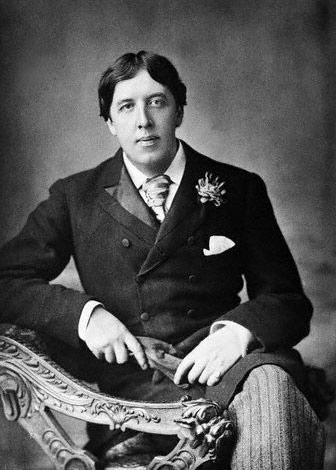![[Home]](/graphics/2020-02_logo.png)
![[Home]](/graphics/2020-02_logo.png)
 By GaryBrooks?
By GaryBrooks?
In the later decades of the nineteenth century, a new theory challenged conventional Victorian thought by proclaiming that the central purpose of art was not to be morally, intellectually, or socially uplifting, but rather to provide sensual pleasure: the goal was to “exist beautifully”. Not everyone was impressed, however, and the aesthetic movement’s critics proclaimed it to be empty and self-indulgent. The well known author-musician team of W.S. Gilbert and Arthur Sullivan satirized the movement in their 1881 comic operetta Patience, the world’s first theatrical production to be lit entirely by electric lights. Ever the clever promoter, impresario Richard D’Oyly Carte decided to hire Oscar Wilde to tour the United States and Canada as a lecturer on aesthetics as a way of promoting the new operetta before its North American tour.
In 1881, Wilde’s writings -— aside from a slim volume of poems -— lay in the future, but at Magdalen College, Oxford, he had become well known for his espousal of the aesthetic and decadent movements. “He wore his hair long, openly scorned ‘manly’ sports though he occasionally boxed, and decorated his rooms with peacock feathers, lilies, sunflowers, blue china and other objects d’ art, once remarking to friends whom he entertained lavishly, ‘I find it harder and harder every day to live up to my blue china’.” Graduating with a double first in Greek and Latin, Wilde launched himself on the London public as a self-proclaimed “Professor of Aesthetics and an arbiter of taste.”
Due to its commercial success, Wilde’s North American lecture tour, originally scheduled to last four months, stretched to almost a year. On his arrival in New York at the beginning of January, 1882, Wilde told waiting reporters that he had been disappointed in the Atlantic, but he probably did not announce to customs inspectors that he “had nothing to declare but his genius”, a comment that was attributed to him only years after his death and for which there is no contemporary record.
The industrialization of America, in Wilde’s view, had lead to a preoccupation with the purely utilitarian at the expense of the aesthetic. His goal for the lecture tour was to encourage Americans’ appreciation of beauty -— and of himself. The topics of the lectures, his own choice, were The Decorative Arts and The House Beautiful. His typical attire while delivering them was breeches and a velvet coat with lace trim.
Near the end of his North American tour, Wilde visited Atlantic Canada, arriving in Halifax on October 8, 1882. While in the city he stayed at the WaverleyInn, a still popular hotel. His arrival in the city was highly anticipated. As Mary Elizabeth Smith (1995) has noted, advertisers were quick to jump on the bandwagon: the October 10, 1882 Morning Herald, for example, carried an ad which ran: “Oscar himself is not arrayed in better velveteen than is sold daily by Blakely and Co.”
The lectures were given in the Academy of Music, the first purpose-built theatre in Halifax. It was a building of which the city was justifiably proud, and that civic emotion is clear in a contemporary statement quoted by Smith (p.412): the Academy of Music was a “building furnished with every modern improvement for entertainments of all kinds whether oratorical, musical, or theatrical, an edifice reflecting credit on those whose money has built it and on the city at large.” The large brick theatre opened in 1877, five years before Wilde’s visit. It had seating for 1250 on three levels. It was situated in the city’s increasingly fashionable south end—on Pleasant (now Barrington) Street, at the foot of Spring Garden Road. It shared a block with St. Matthew’s Church and Government House. After WWI the building was rechristened the Majestic Theatre and used primarily as a cinema. It was torn down in 1929 to make way for the Capitol Theatre which, in turn, was demolished in 1974 and replaced by the Maritime Centre.1
 The Academy of Music
The Academy of Music
Wilde’s lecture on The Decorative Arts proved popular, with a reported 1400 attending (some presumably with standing room only). The second night, his talk on The House Beautiful was less well attended, attracting only 400 or so.
Wilde’s visit to Halifax occasioned considerable interest and, as Smith (1995) describes, almost as much comment. The Acadian Recorder, for example, described the event as “full of beautiful moonshine.” The Morning Chronicle, on the other hand, considered Wilde to be “decidedly effeminate” and stated that he spoke “the dullest bosh”, although a report in the same newspaper the following day described him as an “educated man” who wove “wondrous word pictures.” Not surprisingly, that defender of Victorian proprieties, the Presbyterian Witness, proclaimed him “immoral and disgusting,” an assessment that would no doubt have more amused Wilde than upset him. “The most stinging criticism came from one member of the public, writing in a letter to the editor, describing Wilde as a ‘narrow-headed, pindle-shanked, shakey, ungraceful specimen of manhood”2. It was to be a long time before his visit was forgotten.
RobinMetcalfe and several others in Halifax assembled into the WildeBunch to produce Wilde In The Streets a series of works which included mounting the play about his trial. See the link to that page for full information.
This page is part of the HistoryProject.